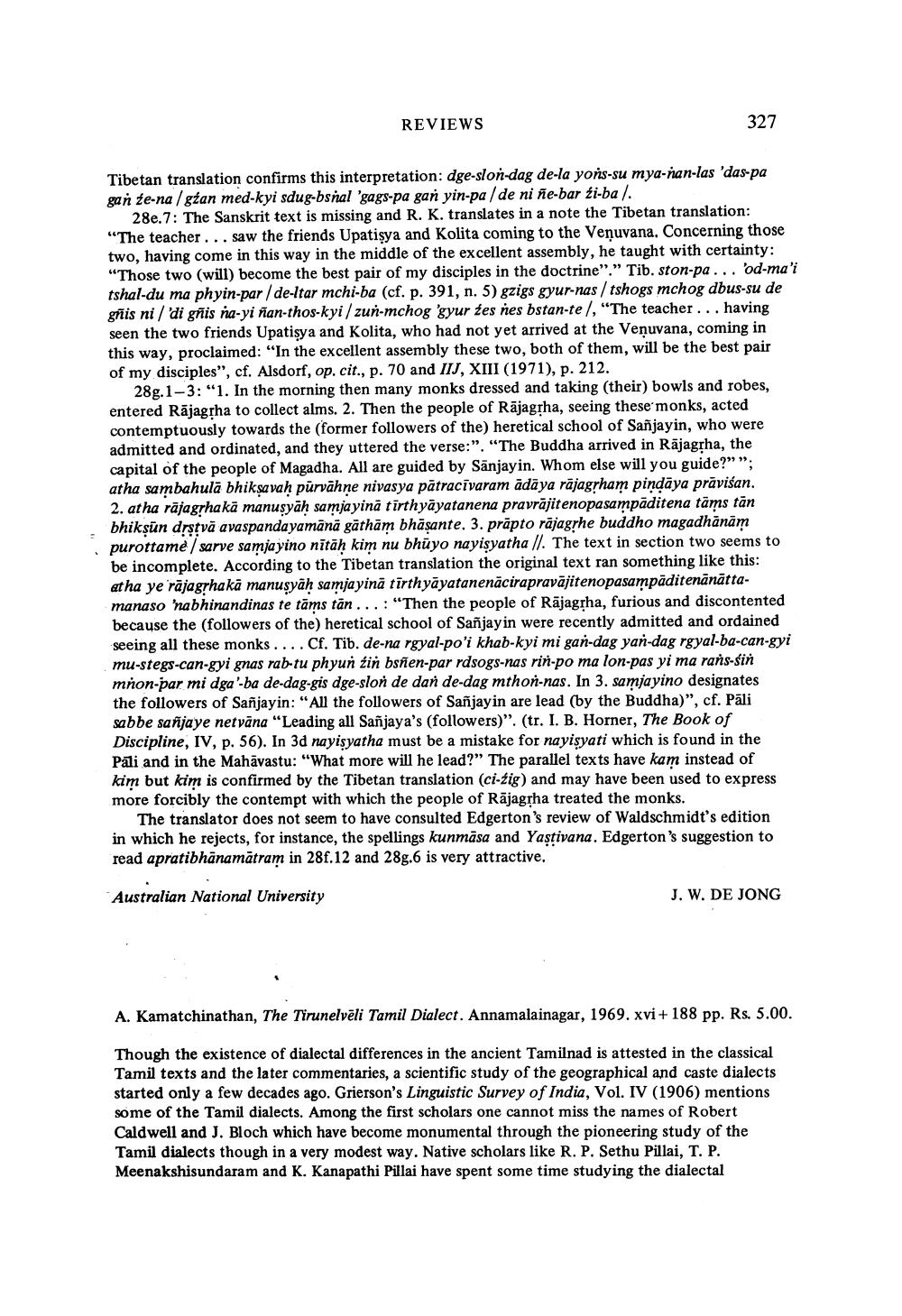________________
REVIEWS
327
Tibetan translation confirms this interpretation: dge-slon-dag de-la yons-su mya-nan-las 'das-pa gan te-na/gźan med-kyi sdug-bsnal 'gags-pa gan yin-pa / de ni ñe-bar ti-ba /.
28e.7: The Sanskrit text is missing and R. K. translates in a note the Tibetan translation: "The teacher... saw the friends Upatisya and Kolita coming to the Veņuvana. Concerning those two, having come in this way in the middle of the excellent assembly, he taught with certainty: "Those two (will) become the best pair of my disciples in the doctrine"." Tib. ston-pa... 'od-ma'i tshal-du ma phyin-par/de-ltar mchi-ba (cf. p. 391, n. 5) gzigs gyur-nas/tshogs mchog dbus-su de gnis ni/'di gnis na-yi ñan-thos-kyi/zun-mchog 'gyur źes nes bstan-te /, "The teacher... having seen the two friends Upatisya and Kolita, who had not yet arrived at the Veņuvana, coming in this way, proclaimed: "In the excellent assembly these two, both of them, will be the best pair of my disciples", cf. Alsdorf, op. cit., p. 70 and IIJ, XIII (1971), p. 212.
28g.1-3: "1. In the morning then many monks dressed and taking (their) bowls and robes, entered Rajagṛha to collect alms. 2. Then the people of Rajagṛha, seeing these monks, acted contemptuously towards the (former followers of the) heretical school of Sañjayin, who were admitted and ordinated, and they uttered the verse:". "The Buddha arrived in Rajagṛha, the capital of the people of Magadha. All are guided by Sanjayin. Whom else will you guide?""; atha sambahula bhikṣavaḥ pūrvähne nivasya patracīvaram ādāya rājagṛham pindaya prāvisan. 2. atha rajagṛhakā manuṣyaḥ samjayinā tīrthyāyatanena pravrajitenopasampaditena tāms tān bhikṣün dṛṣṭvā avaspandayamānā gāthām bhāṣante. 3. prapto rajagṛhe buddho magadhānām purottame/sarve samjayino nītāḥ kim nu bhuyo nayiṣyatha //. The text in section two seems to be incomplete. According to the Tibetan translation the original text ran something like this: atha ye rajagṛhakā manuṣyaḥ samjayinā tīrthyāyatanenācirapravājitenopasampaditenānāttamanaso 'nabhinandinas te tāms tan...: "Then the people of Rajagṛha, furious and discontented because the (followers of the) heretical school of Sañjayin were recently admitted and ordained seeing all these monks.... Cf. Tib. de-na rgyal-po'i khab-kyi mi gan-dag yan-dag rgyal-ba-can-gyi mu-stegs-can-gyi gnas rab-tu phyun tin bsñen-par rdsogs-nas rin-po ma lon-pas yi ma rans-sin mnon-par mi dga'-ba de-dag-gis dge-slon de dan de-dag mthon-nas. In 3. samjayino designates the followers of Sañjayin: "All the followers of Sañjayin are lead (by the Buddha)", cf. Pāli sabbe sanjaye netvāna "Leading all Sañjaya's (followers)". (tr. I. B. Horner, The Book of Discipline, IV, p. 56). In 3d nayiṣyatha must be a mistake for nayisyati which is found in the Pali and in the Mahāvastu: "What more will he lead?" The parallel texts have kam instead of kim but kim is confirmed by the Tibetan translation (ci-źig) and may have been used to express more forcibly the contempt with which the people of Rajagṛha treated the monks.
The translator does not seem to have consulted Edgerton's review of Waldschmidt's edition in which he rejects, for instance, the spellings kunmāsa and Yaṣṭivana. Edgerton's suggestion to read apratibhānamātram in 28f.12 and 28g.6 is very attractive.
Australian National University
J. W. DE JONG
A. Kamatchinathan, The Tirunelveli Tamil Dialect. Annamalainagar, 1969. xvi+ 188 pp. Rs. 5.00.
Though the existence of dialectal differences in the ancient Tamilnad is attested in the classical Tamil texts and the later commentaries, a scientific study of the geographical and caste dialects started only a few decades ago. Grierson's Linguistic Survey of India, Vol. IV (1906) mentions some of the Tamil dialects. Among the first scholars one cannot miss the names of Robert Caldwell and J. Bloch which have become monumental through the pioneering study of the Tamil dialects though in a very modest way. Native scholars like R. P. Sethu Pillai, T. P. Meenakshisundaram and K. Kanapathi Pillai have spent some time studying the dialectal




